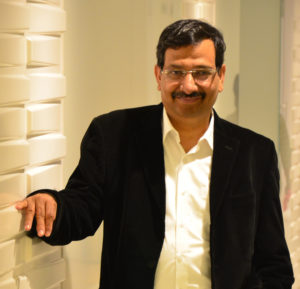Polaris’ Arun Jain has engineered a unique strategy at the mid-sized financial technology company, incubating a robust products company from within a running services entity. He has put together an A-Team of five CEOs to mastermind two companies born out of this vertical split – one in IT services and the other in financial technology products with four lines of businesses.

In a letter addressed to shareholders, Arun Jain, Executive Chairman, Polaris Financial Technology Ltd. (Polaris), used the following words to describe Polaris 4.0, the next stage of the Rs. 2,400-crore (annual revenue of Rs. 2,424 crore in FY13-14) IT services firm. He said, “The next evolution of the company will have the soul of a startup.” A conversation with Jain will make you understand why such words are not mere media speak but thoughts which will be backed by thorough execution.
Jain, a first-generation entrepreneur and an engineer from Delhi College of Engineering, founded Polaris in 1993. By 2001, he scaled up the company to touch Rs. 269.6 crore in revenues by focusing on the banking, financial services and insurance (BFSI) vertical. The next seven years, labeled Polaris 2.0, was a period focused on building intellectual property (IP) and by FY 2008, the company’s revenues scaled up to Rs. 1,099 crore. Polaris 3.0 (2009-11), post the global financial recession, was a period where the company continued to grow revenue and touched Rs. 1,595 crore by FY11.
But the revenue numbers do not give us a complete picture of a big opportunity and transformation that was beginning to take shape. In reality, Polaris was actually two businesses – a services business, where customer was at the center of any process and everything was custom built and a products business, where solving an industry-wide problem through generic solution was the focus. Jain says, “I think the first touch point we had with the products business came with the acquisition of OrbiTech and its IP, but we didn’t act upon the realisation that these are two fundamentally different businesses.”
2012 onwards, Jain presided over a strategy that was unique. Two new frameworks were established – COPARIS framework to help its customers (most in the BFSI space) deal with seven layers of complexity and a BOTIS framework to ensure fail-safe design in a period of transformation.
There was something else that happened; the organisational structure was slowly being reset to split services and product verticals. In FY14, when the company touched Rs. 2,424 crore in revenue, the services vertical contributed 79 per cent. This meant the products business contributed Rs. 510 crore and could, potentially, stand on its own two feet and pursue its own, independent strategy.
In April 2013, after board approval and recommendations of a task force, the company internally announced the formal restructuring. Jain says, “Of course, we wanted to observe two clear quarters of how it would affect operations – decision-making, cycle time, customer satisfaction etc.” It was a period of careful observation for impact on employees, customers and shareholders and to tackle any blind spots that would arise. In March 2014, a demerger was announced and is in the process of completion as this article runs in print.
As Jain often repeats through the interview the two entities are very different from each other. From an investor perspective, services and products have completely different risk-reward profiles. From an employee perspective, the fundamental mindset and DNA needed is different. And for customers, solving a problem can be done either through products or product-agnostic services but the method one adopts depends on various factors.
In this feature, we capture a glimpse of how Jain engineered this demerger and his vision for both the companies, going forward.

Planting the initial seed
Jain believes that his first brush with products began with the acquisition of OrbiTech in 2002, then a subsidiary of Citibank. Jain says, “I thought it was a bold acquisition at the time; buying a subsidiary of an MNC wasn’t something very common then. The most interesting aspect (of the acquisition) was the amount of un-monetised IP the company had.”
Over the next few years, the company constantly built both businesses – services and products. Jain explains that one possible disadvantage of this approach is the sub-optimal attention given to both types of business, each of which are uniquely different. However, those days, it wasn’t easy to raise big money in India for products-only businesses and compete against the SAPs and ORACLEs of the world. Instead, Jain adopted a strategy of investing money from internal accruals to constantly build the products business, slowly but surely.
Today, after the demerger, the strategy of both verticals has been laid out with clarity. The services vertical will focus on four themes – digital, data, risk and payments – and will be led by Jitin Goyal, a former member of the Tier-I leadership team at Infosys and head of financial services for Europe.
On the other hand, the products company, now called Intellect Design Arena will be led by Manish Maakan, CEO, Global Transaction Banking; Jaideep Billa, CEO, Global Consumer Banking; Venkatesh Srinivasan, CEO, Risk & Treasury Management; and Pranav Pasricha, CEO, Insurance Products.
Jain adds, “The important aspect is that each of these CEOs has their own senior management team with relevant experience in both technology and vertical expertise in the financial technology industry. At a fundamental level, as an entrepreneur-CEO, I have realised that we need to pay at standard industry levels and attract top-notch talent across various facets of each vertical; there is no place for mediocrity.”
From the ground up
In 2012, Jain led an internal ideas-gathering session (branded as ‘Lakshya’ within the firm) with almost all employees of the company. Jain recollects, “In one of the sessions in Hyderabad, attended by over 250 people, we noted down the list of opportunities that were visible. On the services front, there were various opportunities with the customer at the center. And on the products front, there were several directional approaches one could take keeping in mind that a single solution could tackle an industry-wide problem.”
While the Lakshya exercise did set the direction to do a vertical split, Polaris treaded carefully. The Board appointed Boston Consulting Group (BCG) to further explore this thesis. Jain says, “BCG brought in several case studies to illustrate their recommendations. We also setup a task force led by senior Polaris leaders including Jaideep Billa, Natarajan Narayanasamy, Anil Verma and Rajesh Saxena.”
Jain admits that both these approaches (products or services) seemingly looked grey from a client standpoint. But a deeper analysis (conducted by an internal task force) proved that wasn’t the case.

Specifically, the services vertical required a tightly integrated delivery/client-focused organisation, the freedom to choose third-party solutions outside of the Polaris product suite and a leadership team that was closer to the market.
The products business needed greater upfront research and development investment, much higher sales and marketing budgets not influenced by a services mindset and partnerships with third-party system integrators who would use the ‘Intellect’ suite of products.
Jain adds, “These were the top level recommendations but that is not all. Such a course of action requires an enterprise-wide shift in thinking. This required the design of something like the FT 8012 Design Center to internalise the concept of ‘design thinking’ to our team members.”
The 8012 FT Design Center is the first design center for financial technology, a world-class facility that Jain masterminded. Global clients – banks and financial institutions are invited to ‘co-create’ solutions in an environment designed to bring about a touch-and-feel layer to the concept of design thinking.
Thinking of design
For this feature, Jain explained to us what he means by the concept of design thinking.
“It’s a four-step process,” he says. “First, one has to feel the emotional side of how a customer, investor and employee will react. Second, one has to observe the common patterns in the entire industry. Third, to connect the dots among all these different happenings and finally, unearth the blind spots,” says Jain, adding a theoretical layer to his explanation.
This methodical approach meant that the demerger process went on smoothly from all standpoints. For example, Jain and his senior team conducted informal sessions with various subject matter experts and external consultants on what the regulatory expectations were from a documentation standpoint. Jain says, “We uncovered a fund of information from such sessions and acted upon the findings. Our thorough work in this regard meant that there were no delays in response from regulatory bodies or the court.”
To be sure, the concept of design thinking is something the company wants to use in both its services and products businesses across processes; right from the macro level, where business, technology, people and operations come together to the level of adding features to a particular product.
The macro vision
Polaris 4.0 also earmarks a new phase in the entrepreneurial journey of Jain. A 25-year veteran in this industry, Jain’s day-to-day role now includes that of a coach for his five CEOs. He says, “I am glad to say that we’ve now attracted the best of talent from the industry. My personal role will be to help our CEOs uncover any blind spots they encounter, be it in strategy, systems, style or organisational structure.”
Additionally, Jain also runs workshops with his team members – project managers and above. Branded Unmukt, these workshops focus on upping the aspirational quotient of his people. “In addition to skill development, one of the key aspects of building organisations is to improve the mindset of people,” he adds. Jain’s theory is that the whole organisation needs to be aligned to specific purposes. If one of the company’s goals is to reduce complexity in the customer environment, this whole thought has to be internalized, by the entire organisation.
With the de-merger almost complete, Jain and his team are now gearing up for the next phase of growth. When Jain used the words ‘soul of a startup’ in his note to shareholders, he was referring to the renewed agility of each line of business, a spirit of entrepreneurship where each CEO is completely empowered to grow his piece of the business and to unearth the potential of a powerful enterprise in its own right.
THE ROLE OF DESIGN THINKING IN DECISION-MAKING IS A FOUR-STEP PROCESS.
Jain wants to use the concept of design thinking across the board, right from macro level decision-making to the level of adding features to a particular product.
Feel the emotional side of any decision
Observe the common patterns (across the industry)
Connect the dots among all these different observations
Unearth the blind spots
Polaris 1.0
Till 2001: Touched Rs. 296 crore in revenue with a deep focus on financial technology sourcing for the BFSI industry
Polaris 2.0
2002-2008: Touched Rs. 1,099 crores in revenue, focus on IP building, acquired OrbiTech from Citibank.
Polaris 3.0
2009-2011: Touched Rs. 1,595 crores; complexity reduction for clients, worked with leading global firms in banking, financial services and insurance
Polaris 4.0
2012 onwards: Touched Rs. 2,424 crores in FY 2014. De-merger of services and products division. Deep focus on design thinking as a strategy for execution. Five CEOs hired to scale each line of business.
A PEEK INTO INTELLECT DESIGN ARENA, THE DE-MERGED PRODUCTS BUSINESS
4 Lines of Businesses
Global Universal Banking (GUB), Risk and Treasury Management (RTM), Global Transaction Banking (GTB) and Insurance
Key customer wins
Several market leaders – A Central Bank in Europe, Trade division of a UK-based global financial services provider, Bank in the UAE, Canada-based financial institution, and Top 5 Payment provider in the US
Specialties in each LoB
GUB business will focus on Core Banking, Lending, Wealth, Cards, Active Branch and Quantum Core for Central Banks
RTM will specialize in shifting gears from managing risk to leveraging risk for business advantage
GTB business will particularly focus on CBX, Payments, Customer Onboarding and Liquidity
Insurance will provide differentiated solutions in Claims, Life Claims, Distributed Solutions, Underwriting Workstation, Business apps and components
Arun Jain BFSI Financial Technology Global Transaction Banking Global Universal Banking Insurance Intellectual Property Polaris Risk and Treasury Management